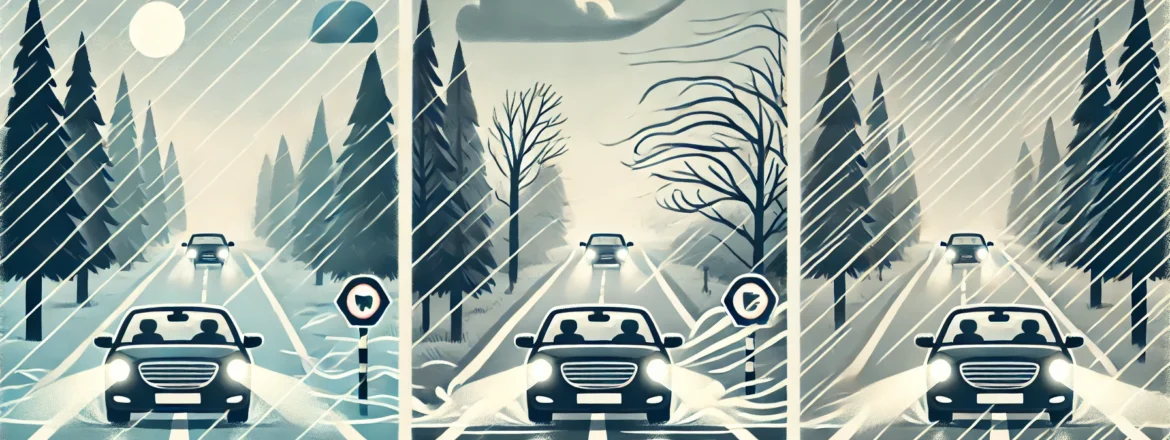Driving in challenging weather conditions requires extra caution and preparation. Rain, wind, and fog create unique risks that can lead to accidents if not managed carefully. This guide provides practical tips to help you stay safe when driving in adverse weather conditions.
Table of Content
- Why Weather Affects Driving
- Driving Safely in the Rain
- Tips for Driving in Windy Conditions
- Navigating Roads in Foggy Weather
- General Tips for All Weather Conditions
- Safety Tips Visual Chart
- Frequently Asked Questions
Why Weather Affects Driving
Bad weather reduces visibility, traction, and control, increasing the likelihood of accidents. Each type of weather presents its own challenges:
- Rain: Causes slippery roads and reduced braking effectiveness.
- Wind: Affects vehicle stability, especially for high-profile vehicles.
- Fog: Limits visibility, making it hard to see other vehicles or road signs.
Driving Safely in the Rain
Rain is one of the most common causes of road accidents. Here’s how to stay safe:
1. Slow Down
- Wet roads reduce traction, increasing the stopping distance.
- Drive below the speed limit to maintain better control.
2. Check Your Tires
- Ensure your tires have proper tread depth and are inflated to the correct pressure.
3. Use Your Headlights
- Turn on low-beam headlights to improve visibility and help others see you. Avoid using high beams, which can reflect off the rain and reduce visibility.
4. Avoid Hydroplaning
- Hydroplaning occurs when tires lose contact with the road due to water.
- To prevent it, avoid sudden turns or braking, and drive in the tracks of the vehicle ahead.
Tips for Driving in Windy Conditions
Strong winds can push your car off course or make it harder to steer.
1. Keep a Firm Grip on the Steering Wheel
- Use both hands to maintain control, especially when driving on open roads.
2. Beware of High-Profile Vehicles
- Trucks, buses, and vans are more affected by wind gusts. Stay clear of them when passing or being passed.
3. Adjust Your Speed
- Drive slower than usual to counter sudden gusts of wind.
4. Anticipate Crosswinds
- Be prepared for sudden changes in wind direction when driving near bridges, tunnels, or open areas.
Navigating Roads in Foggy Weather
Fog is one of the most dangerous weather conditions for drivers due to reduced visibility.
1. Use Fog Lights or Low Beams
- Avoid high beams, as they can reflect off the fog and worsen visibility.
2. Slow Down
- Drive at a speed that allows you to stop within the visible distance ahead.
3. Use the Right Lane
- Stay closer to the right-hand edge of the road to avoid oncoming traffic.
4. Avoid Stopping in the Middle of the Road
- If you must stop, pull over to the shoulder and turn on your hazard lights.
General Tips for All Weather Conditions
- Keep a Safe Following Distance
- Increase the gap between your car and the vehicle in front to allow more reaction time.
- Avoid Sudden Movements
- Gradual acceleration, braking, and steering reduce the risk of losing control.
- Inspect Your Car Regularly
- Check wipers, lights, and tires before driving in bad weather.
- Stay Alert
- Keep distractions to a minimum and focus fully on the road.
Safety Tips Visual Chart
| Weather Condition | Key Challenges | Safety Tips |
|---|---|---|
| Rain | Slippery roads, reduced visibility | Slow down, check tire tread, use low beams, avoid sudden braking. |
| Wind | Vehicle instability | Maintain a firm grip on the wheel, drive slower, and beware of high-profile vehicles. |
| Fog | Low visibility | Use fog lights or low beams, slow down, and stay in the right lane. |
Frequently Asked Questions
1. How do I prepare my car for bad weather?
Ensure your wipers, headlights, and tires are in good condition. Carry an emergency kit with essentials like a flashlight, blanket, and first-aid supplies.
2. What should I do if I start hydroplaning?
Ease off the accelerator, keep the steering wheel steady, and avoid sudden braking until your tires regain traction.
3. Can I use cruise control in rain or fog?
No, cruise control reduces your ability to react quickly to changing road conditions.
4. How can I avoid accidents in foggy weather?
Reduce your speed, use fog lights or low beams, and follow road markings to stay in your lane.
5. What’s the safest way to drive in strong wind?
Drive slower, keep a firm grip on the wheel, and stay clear of large vehicles that are more affected by wind gusts.


